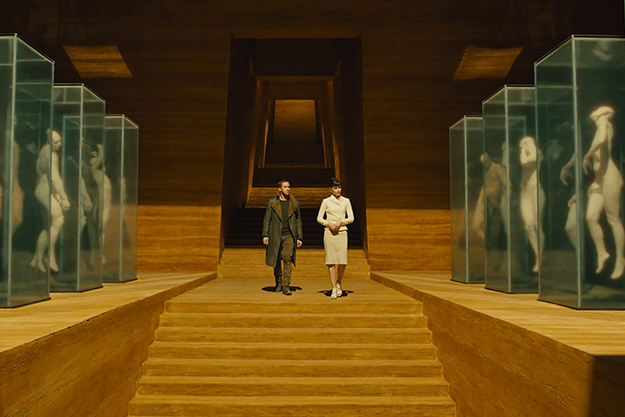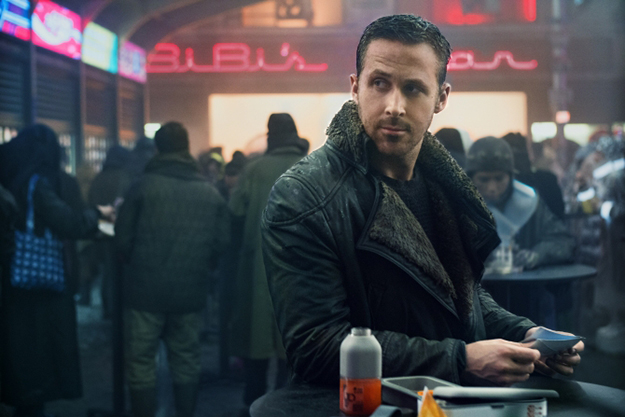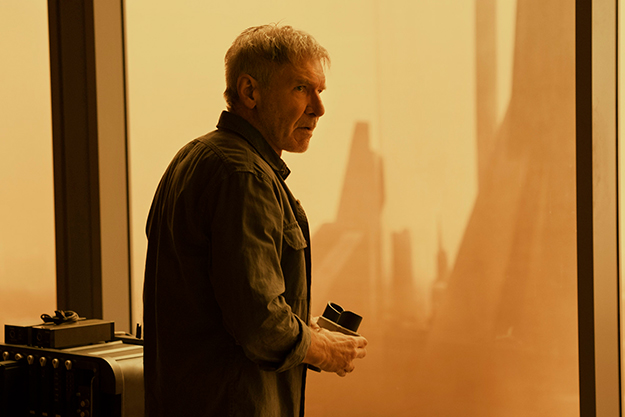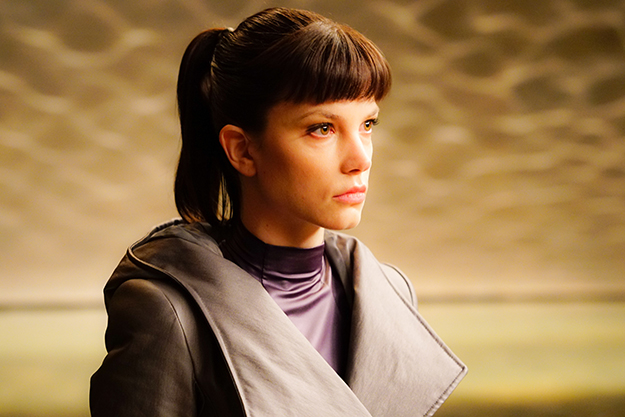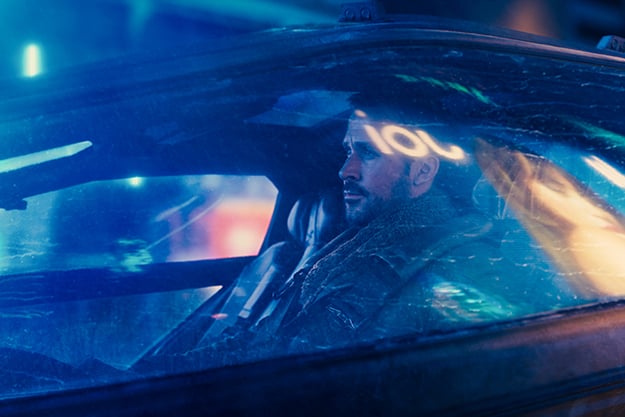Harrison Ford returns again, a ghost out of the past, in Blade Runner 2049, just as he did as Han Solo in Star Wars: The Force Awakens. Ford may have become Hollywood’s professional revenant, but it’s in the context of an imaginative climate that’s very much to do with summoning up ghosts, infusing uncanny new life into familiar old shapes (cf. the Twin Peaks revival). Blade Runner 2049 has the authentically eerie feel of a séance, not least in a scene set in a desolate, long-deserted Las Vegas hotel, where the hologram ghosts of Elvis, Marilyn, and Liberace abruptly flicker on and off in the darkness. As Ford’s returning character Deckard and new-generation android hunter K stalk each other through the shadows, a glowing phantom Elvis gives us a sudden burst of “Can’t Help Falling in Love,” and the line that jumps out at you is, “Some things were meant to be.” Fate and predestination—or, in this story about artificial life, pre-programming—are key themes of Blade Runner 2049, although it was by no means evident that this film was meant to be. The idea of a belated sequel to one of the most influential and (the word seems appropriate) haunting science-fiction films could have seemed as pointless as a hypothetical The Shining: Return to the Overlook or an actual Alien: Covenant. Given how appallingly Ridley Scott devalued the Alien mythos in that film and its precursor Prometheus, it’s a relief that he kept his directorial hands off the property that he created in 1982, and restricted himself to the executive producer role. Blade Runner’s world instead has been entrusted to the stewardship of Denis Villeneuve, working with a script by Hampton Fancher, who co-wrote the original film, and Michael Green (Logan, Alien: Covenant). The good news is that this team have done a fine job. The better news is that they’ve made something altogether dazzling. Villeneuve is an intellectually ambitious, aesthetically refined director who can sometimes tend to grandiosity and a rather self-regarding notion of “quality,” as in last year’s Arrival; but that he has an eye, an imagination, and a sense of the widest possible amplitude of a fictional universe is very evident in Blade Runner 2049. This film’s world is not so much a re-creation, more a refinement or a variation on the future USA of Scott’s film. Shot by Roger Deakins and designed by Dennis Gassner, the film’s look privileges an often gasp-inducing monumentalism—cavernous abandoned buildings with sometimes a touch of Stalin-era Russia, vast near-dead cities pictured in swooping aerial vistas, spa-like interiors shimmering with severe, otherworldly elegance.
But equally striking is the meticulous concentration on texture: in the CGI age of glossy, hyper-detailed yet insubstantial images, what’s remarkable about BR2049—and one reason why you should see it on as big a screen as possible—is its use of sensuous detail. In a future world in which immaterial pictures are everywhere—like the towering hologram women that flicker in the L.A. night sky—reality seems to take refuge in the small grain of physical texture. Much of this film’s visual poetry comes from the tactility of earth, metal, wood, fabric, rust, things often held in the palm of a character’s hand. The same sense of detail applies to Theo Green’s sound design: listen to the insistent scraping noise made by a cooking pot on a hob in the opening sequence (which in mood, before the flying-fist action kicks in, is as close to Tarkovsky’s Stalker as anything I’ve seen in an American movie). Narratively, there’s some catching up to do at the start, with a set of captions that need attentive reading if you want to get up to scratch. Here’s the gist: 30 years on, the Tyrell Corporation that once manufactured androids, or replicants, has gone bankrupt; a new God-like inventor-industrialist, Niander Wallace, has created a more pliable breed of artificial humans, including the next generation of blade runners, still busy “retiring” the old rogue replicants; California has been transformed by massive climate change, so that a sea rages outside L.A.’s protecting wall, and near-constant snow falls on the city (the snowy night air is another example of the bewitching textures that fill the film); and a massive data crash, the “Blackout,” has wiped out all electronic records of the past (keep your cherished family photos in hard copy, the film warns us in passing). The hero this time is new-model blade runner KD6-3.7 (Ryan Gosling)—K for short (as in Kafka, or as in Philip K. Dick?). His artificial origins explain his languid sangfroid, as well as his robustness when getting into fisticuffs at the start with fugitive replicant Morton (Dave Bautista). Beneath a wizened tree in a frost-cloaked wasteland, K discovers a buried cache of bones that suggest that everything known about replicants is about to change; K’s boss, LAPD Lt. Joshi (Robin Wright, commandingly steely), wants him to lose the evidence. But the mystery also puts him on the track of Deckard, last seen—in at least one of the multiple versions of Scott’s Blade Runner—flying off into the unknown, his own identity in question.
Whether or not this sequel will entirely make sense to newcomers is a moot point. But elements of the original turn up in intriguing reconfigurations, showing that Villeneuve’s regard to the original is anything but slavish. Here’s Edward James Olmos as officer Gaff, now retired but still making his little paper animals. The all-important origami unicorn is, as it were, reincarnated as a little wooden horse. This object is mysteriously related to the false (or are they?) memories implanted into K’s mind as part of his programming, which help equip him with the nearest he has to a soul: the horse is K’s Rosebud, as it were. The story revolves around K’s attempt to solve a mystery which turns out, as happens in your more existential thrillers, to be partly his own mystery. As in the original, the underlying question is about whether androids have, or could ever have, souls. Perhaps the old, rebellious replicants did: “You’ve never seen a miracle,” Morton snarls at K, suggesting that his new generation will never be susceptible to the sublime. But maybe K is; at least, he has a yearning for love, or its image. He lives alone—or rather, in the company of Joi (Ana de Armas), a hyperreal hologram of a simulated girlfriend that he’s bought off the peg (this is where the film really catches the spirit of Blade Runner’s original inspiration, Philip K. Dick). She’s operated by a ceiling-mounted mechanism until K buys a device that allows Joi to leave the confines of the apartment and become fully portable—which is to say, to come one step nearer to being autonomous, an almost-real woman. She’s programmed to act as if she’s real, gazing in wonder at her translucent, shimmering hands when she first steps outside with K (hands and the sense of touch are a major leitmotif, right up to a final shot that may be Villeneuve’s sly nod to his own Arrival). The way that Joi hovers on the cusp of artificiality and empathetic realness is made intensely vivid in the extraordinary moment when the plane she’s riding with K is shot down. Just before her projected form cuts out into nothing, her form briefly flickers, and her anxious “K?” is incredibly poignant: a glimmer of vulnerable anxiety (or its perfect imitation) in a genre that doesn’t always deal with feelings in their more nuanced forms.
Joi is the film’s most fascinating, most problematic figure: a 3D refinement of Apple’s chimeric Siri, or the seductive disembodied female entity that was the invisible heroine of Spike Jonze’s Her. Played brilliantly and troublingly by Ana de Armas, Joi is patently presented as a commercial objectification of female desirability—girl next door, fashion plate, sex doll, solicitous dream wife—and her unreality is established by giving an exaggerated ingénue cuteness to de Armas’s look. The filmmakers have even, against the odds, managed to come up with a genuinely novel variation on the science-fiction holy grail of future sex: a hooker, Mariette (Mackenzie Davis), joins Joi and K for a virtual threesome which involves the two women’s bodies, one real, one made of light, eerily merging. De Armas’s Joi doesn’t entirely transcend the stereotype of dream-girl passivity, but she pushes at the limits—or, in certain scenes, appears to enact a sort of critical parody of the generic baffled girlfriend clinging to the hero’s side. Meanwhile, the film is peopled by other women, human or synthetic, that embody various degrees of irreducible agency: Mariette, Joshi, a mysterious woman in black (Hiam Abbass) who turns out to represent a new revolutionary movement, and Wallace’s ruthless lieutenant and creation Luv (Sylvia Hoeks), a silky-voiced, dead-eyed executive and executioner. There’s also Dr. Ana Stelline, played by Carla Juri—a bubble-dwelling scientist who designs the dreams that are implanted in replicants’ minds: a hyper-sophisticated upgrade of Ellen Page’s Ariadne character in Inception. The scene which introduces her is quite astonishingly beautiful, a philosophical rethinking of the aesthetic potential of VFX artifice, and an entrancing representation of how a god might go about her work (if a god were equipped with a precise, hyper-vivid imagination and a nifty camera-like gizmo hung around her neck). Dr. Stelline is a figure of what a benign creator (or auteur) might be, in contrast to the evil autocratic god represented by Jared Leto’s Wallace, a blind mogul who lives in a palace of extraordinary beauty that he can’t see. Kin to Joe Turkel’s Tyrell in the original film, and to the flawed demiurge played by Guy Pearce in the last two Alien episodes, Wallace is, I’m afraid, the one great flaw in the film—a Bond villain placed on a phony transcendental pedestal, and acted with wooden portentousness by Leto (it doesn’t help that, as in some of Luv’s scenes, Leto’s dialogue is often all but incomprehensibly drowned in eerie echo).
Wallace does have some of the film’s best décor, though. Echoing the original Tyrell ziggurat, his mausoleum-like is like a huge billionaire health spa, where huge dark rooms shimmer with watery reflections and amber light; in the lobby, a slash of that light rhymes with the murkier canyons of light that cut through the crammed slabs of building in the city outside. Roger Deakins shows himself again to be one of cinema’s great masters of light and space—something he demonstrated to jaw-dropping effect in a scene in a glass office at night in Bond film Skyfall, also designed by Gassner. He goes one better here in the Las Vegas hologram scene, and in the introduction to the Las Vegas sequence, where K steps through dense red-orange air resembling one of artist James Turrell’s light installations. In terms of photography and design, Blade Runner 2049 arguably outdoes the original—and the fact that it spins variations on something familiar in no way diminishes the achievement. If every new film made today is to a greater or lesser degree an echo box of past possibilities, what’s notable is how much Villeneuve gives those echoes room to breathe and to be new. That is something illustrated quite literally when Harrison’s Deckard speaks the name of the replicant woman he fell for in the first film: Villeneuve allows total silence to fall and what seems like a very long time to pass before Deckard breathes the word “Rachael.” And as far as echoes go, the imposing score by Benjamin Wallfisch and Hans Zimmer pretty much dispenses with melody to concentrate on the tones and textures of Vangelis’s glacial original music—here reprised in the interplay of shrieks and deep bass rumbles, punctuated by distorted metallic fanfares. It all adds to the authentically narcotized feel of a film that perfectly recaptures the tone of the original, but decisively takes it somewhere else. Villeneuve also does some things that Scott didn’t in terms of providing certain mainstream pleasures—there’s a lot more action, with characters tending to pummel each other right through walls when they come to blows, even an explosion or two. Yet it’s all coherent, and we never feel our baser tastes are being pandered to. Take the build-up to the final confrontation: it involves a jet car crashing in torrential rain, but the pace of the editing, together with the slow, somber music, makes the sequence eerie, hallucinatory, in a magnificently counterintuitive way.
K’s hunt for Deckard yields a fascinating theme of oedipal conflict—between the characters but also, implicitly, between two generations of male stars. The film confronts two different types of leading-man image: man of action versus man of thought (or appearance), the rough-hewn old-school edge of Ford versus the cool, somewhat feminine reserve embodied by Gosling. The latter’s habitual detachment here comes into its own as K, a creature constantly, almost absent-mindedly puzzling over his own nature. “To be born is to have a soul, I guess,” K muses in his quiet, airy voice. “You’ve been getting on fine without one,” Wright’s Joshi snaps back at him. Quite apart from what androids do or don’t dream of, you could say that Blade Runner 2049 is implicitly a speculation on whether movie stars—or at least, their images—have souls. A lot of people may feel that this slow, enigmatic, elusive hallucination of a movie doesn’t have a soul—not the sort of agitated, neurotic soul that a Hollywood sci-fi movie more usually has. What it definitely has, however, is a mind, an imagination, a vision of imposing completeness and intensity. “You’ve never seen a miracle,” Morton tells K—but, in a world in which belated sequels to classics ought never to work, Blade Runner 2049 feels miraculous indeed. Jonathan Romney is a contributing editor to Film Comment and writes its Film of the Week column. He is a member of the London Film Critics Circle.
